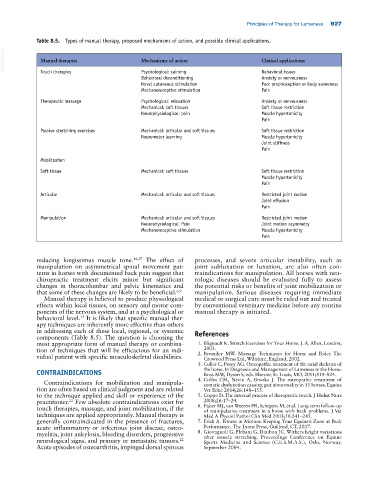Page 961 - Adams and Stashak's Lameness in Horses, 7th Edition
P. 961
Principles of Therapy for Lameness 927
Table 8.5. Types of manual therapy, proposed mechanisms of action, and possible clinical applications.
VetBooks.ir Manual therapies Mechanisms of action Clinical applications
Psychological: calming
Touch therapies
Behavioral deconditioning Behavioral issues
Anxiety or nervousness
Novel cutaneous stimulation Poor proprioception or body awareness
Mechanoreceptive stimulation Pain
Therapeutic massage Psychological: relaxation Anxiety or nervousness
Mechanical: soft tissues Soft tissue restriction
Neurophysiological: pain Muscle hypertonicity
Pain
Passive stretching exercises Mechanical: articular and soft tissues Soft tissue restriction
Neuromotor learning Muscle hypertonicity
Joint stiffness
Pain
Mobilization
Soft tissue Mechanical: soft tissues Soft tissue restriction
Muscle hypertonicity
Pain
Articular Mechanical: articular and soft tissues Restricted joint motion
Joint effusion
Pain
Manipulation Mechanical: articular and soft tissues Restricted joint motion
Neurophysiological: Pain Joint motion asymmetry
Mechanoreceptive stimulation Muscle hypertonicity
Pain
reducing longissimus muscle tone. 14,27 The effect of processes, and severe articular instability, such as
manipulation on asymmetrical spinal movement pat- joint subluxation or luxation, are also often con-
terns in horses with documented back pain suggest that traindications for manipulation. All horses with neu-
chiropractic treatment elicits minor but significant rologic diseases should be evaluated fully to assess
changes in thoracolumbar and pelvic kinematics and the potential risks or benefits of joint mobilization or
that some of these changes are likely to be beneficial. 6,9 manipulation. Serious diseases requiring immediate
Manual therapy is believed to produce physiological medical or surgical care must be ruled out and treated
effects within local tissues, on sensory and motor com- by conventional veterinary medicine before any routine
ponents of the nervous system, and at a psychological or manual therapy is initiated.
behavioral level. It is likely that specific manual ther-
15
apy techniques are inherently more effective than others
in addressing each of these local, regional, or systemic References
components (Table 8.5). The question is choosing the
most appropriate form of manual therapy or combina- 1. Blignault K. Stretch Exercises for Your Horse. J. A. Allen, London,
tion of techniques that will be efficacious for an indi- 2003.
vidual patient with specific musculoskeletal disabilities. 2. Bromiley MW. Massage Techniques for Horse and Rider. The
Crowood Press Ltd, Wiltshire, England, 2002.
3. Colles C, Pusey AG. Osteopathic treatment of the axial skeleton of
CONTRAINDICATIONS the horse. In Diagnosis and Management of Lameness in the Horse.
Ross MW, Dyson S, eds. Elsevier, St. Louis, MO, 2011;819–824.
Contraindications for mobilization and manipula- 4. Colles CM, Nevin A, Brooks J. The osteopathic treatment of
somatic dysfunction causing gait abnormality in 51 horses. Equine
tion are often based on clinical judgment and are related Vet Educ 2014;26:148–155.
to the technique applied and skill or experience of the 5. Coppa D. The internal process of therapeutic touch. J Holist Nurs
practitioner. Few absolute contraindications exist for 2008;26:17–24.
22
touch therapies, massage, and joint mobilization, if the 6. Faber MJ, van Weeren PR, Schepers M, et al. Long‐term follow‐up
of manipulative treatment in a horse with back problems. J Vet
techniques are applied appropriately. Manual therapy is Med A Physiol Pathol Clin Med 2003;50:241–245.
generally contraindicated in the presence of fractures, 7. Frick A. Fitness in Motion: Keeping Your Equine’s Zone at Peak
acute inflammatory or infectious joint disease, osteo- Performance. The Lyons Press, Guilford, CT, 2007.
myelitis, joint ankylosis, bleeding disorders, progressive 8. Giovagnoli G, Plebani G, Daubon JC. Withers height variations
after muscle stretching. Proceedings Conference on Equine
neurological signs, and primary or metastatic tumors. Sports Medicine and Science (C.E.S.M.A.S.), Oslo, Norway.
22
Acute episodes of osteoarthritis, impinged dorsal spinous September 2004.

